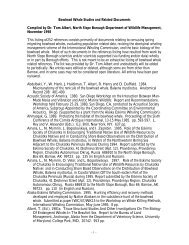ed report 4 page cover - Arctic Research Consortium of the United ...
ed report 4 page cover - Arctic Research Consortium of the United ...
ed report 4 page cover - Arctic Research Consortium of the United ...
You also want an ePaper? Increase the reach of your titles
YUMPU automatically turns print PDFs into web optimized ePapers that Google loves.
GLOBE Program. NSF’s GLOBE Program is funding a partnership project at <strong>the</strong> University<br />
<strong>of</strong> Alaska Fairbanks call<strong>ed</strong> “Seasons: The Global Plant Waves” which grew out <strong>of</strong> connections<br />
made at <strong>the</strong> workshop. When conditions stimulate new plant growth in spring, satellite data<br />
show <strong>the</strong> wave <strong>of</strong> greenup moving across <strong>the</strong> Earth. In o<strong>the</strong>r areas <strong>of</strong> <strong>the</strong> globe, a<br />
simultaneous wave <strong>of</strong> senescence occurs as plant growth decreases. With global climate<br />
change, <strong>the</strong> growing season (<strong>the</strong> period between greenup and senescence) may change. Some<br />
researchers estimate that <strong>the</strong> growing season has increas<strong>ed</strong> in nor<strong>the</strong>rn latitudes by eight days<br />
since <strong>the</strong> early 1980s. Students at four schools in Alaska start<strong>ed</strong> providing ground<br />
observations and verification to <strong>the</strong> remotely sens<strong>ed</strong> data in a pilot protocol in 1998. At <strong>the</strong><br />
end <strong>of</strong> <strong>the</strong> four-year project, organizers anticipate contributions from students all over <strong>the</strong><br />
world. A relat<strong>ed</strong> project still in <strong>the</strong> proposal stage will connect “Seasons” with Alaska Native<br />
ways <strong>of</strong> knowing. The GLOBE Program also provides training for teachers and students<br />
involv<strong>ed</strong> in environmental research (see <strong>page</strong>s 11 and 19).<br />
Live from <strong>the</strong> Poles. As part <strong>of</strong> NSF’s Science and Technology Week, whose 1998 <strong>the</strong>me is<br />
Polar Connections: Exploring <strong>the</strong> World’s Natural Laboratories, Passport to Knowl<strong>ed</strong>ge<br />
(PTK; see <strong>page</strong> 21) develop<strong>ed</strong> Live from <strong>the</strong> Poles, which was support<strong>ed</strong> by NSF, NASA, and<br />
public television and broadcast on 28 April 1998. In this live video program, viewers,<br />
including visitors to <strong>the</strong> Imaginarium in Anchorage, Alaska, interact<strong>ed</strong> with researchers in<br />
Antarctica and a panel <strong>of</strong> arctic experts from <strong>the</strong> Office <strong>of</strong> Polar Programs and <strong>the</strong><br />
Smithsonian’s <strong>Arctic</strong> Studies Center in Washington, DC. The two poles were compar<strong>ed</strong> using<br />
Smithsonian documentary footage <strong>of</strong> <strong>the</strong> <strong>Arctic</strong> and sequences from <strong>the</strong> two previous Live<br />
from Antarctica programs produc<strong>ed</strong> by PTK. Students sent in 45 questions to <strong>the</strong> scientists<br />
by email during <strong>the</strong> broadcast; <strong>the</strong> near real-time answers are available on <strong>the</strong> PTK web site<br />
(http://passport.ivv.nasa.gov/ptk_poles.html). This program advanc<strong>ed</strong> public understanding<br />
<strong>of</strong> research projects in <strong>the</strong> polar regions; a more comprehensive real-time, real-location<br />
exploration featuring investigators on-site in <strong>the</strong> <strong>Arctic</strong> remains to be done.<br />
ARCSS Program. NSF’s ARCSS Program has fund<strong>ed</strong> <strong>the</strong> National Snow and Ice Data<br />
Center at <strong>the</strong> University <strong>of</strong> Colorado to produce an <strong>ed</strong>ucational CD-ROM bas<strong>ed</strong> on <strong>the</strong><br />
longest climate record available, <strong>the</strong> Greenland ice coring projects. Data from <strong>the</strong> American<br />
Greenland Ice Sheet Project 2 (GISP2) and European Greenland Ice Core Project (GRIP)<br />
contribut<strong>ed</strong> to <strong>the</strong> development <strong>of</strong> a curriculum resource for lower high school students to<br />
investigate aspects <strong>of</strong> climate change and climatic variability. The CD-ROM is expect<strong>ed</strong> to be<br />
available in <strong>the</strong> summer <strong>of</strong> 1998.<br />
Toolik Field Station. The multi-institutional Toolik Field Station (TFS) Steering Committee<br />
ask<strong>ed</strong> ARCUS to survey <strong>the</strong> arctic research community to assess support for <strong>ed</strong>ucational<br />
opportunities using TFS facilities (http://www.uafbio.alaska.<strong>ed</strong>u/toolik/toolik.html). ARCUS<br />
distribut<strong>ed</strong> <strong>the</strong> survey in March 1998; respondents express<strong>ed</strong> strong interest and encourag<strong>ed</strong><br />
development <strong>of</strong> <strong>ed</strong>ucational programming. Operat<strong>ed</strong> by <strong>the</strong> Institute <strong>of</strong> <strong>Arctic</strong> Biology <strong>of</strong> <strong>the</strong><br />
University <strong>of</strong> Alaska Fairbanks, TFS, locat<strong>ed</strong> <strong>of</strong>f <strong>the</strong> Dalton Highway about 400 miles north<br />
<strong>of</strong> Fairbanks and 150 miles south <strong>of</strong> Prudhoe Bay, has serv<strong>ed</strong> as a base for field research in<br />
nor<strong>the</strong>rn Alaska since 1975. TFS <strong>of</strong>fers access to an arctic environmental transect along <strong>the</strong><br />
highway corridor from <strong>the</strong> peaks <strong>of</strong> <strong>the</strong> Brooks Range to <strong>the</strong> coastal plain.<br />
18




